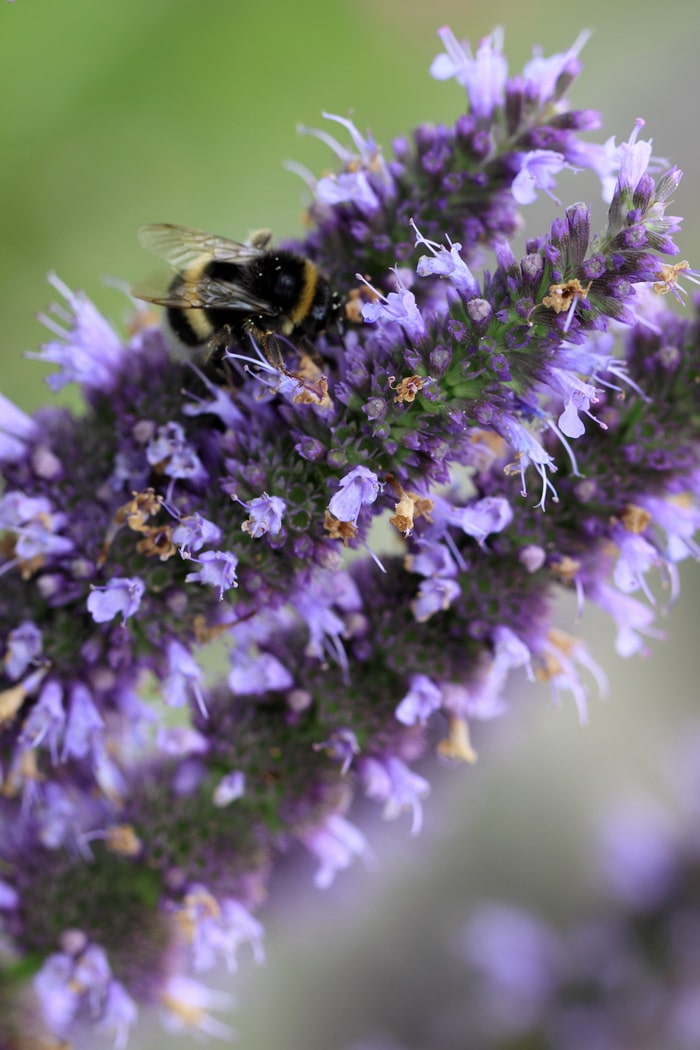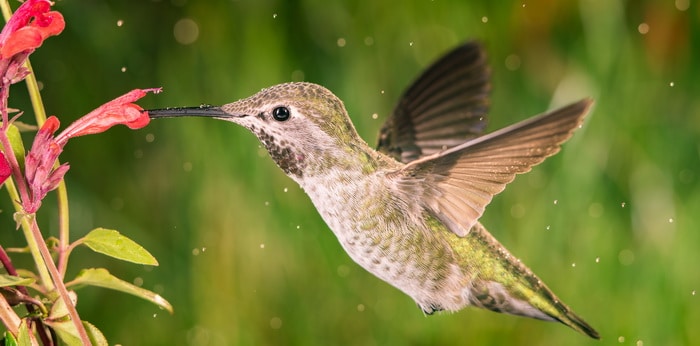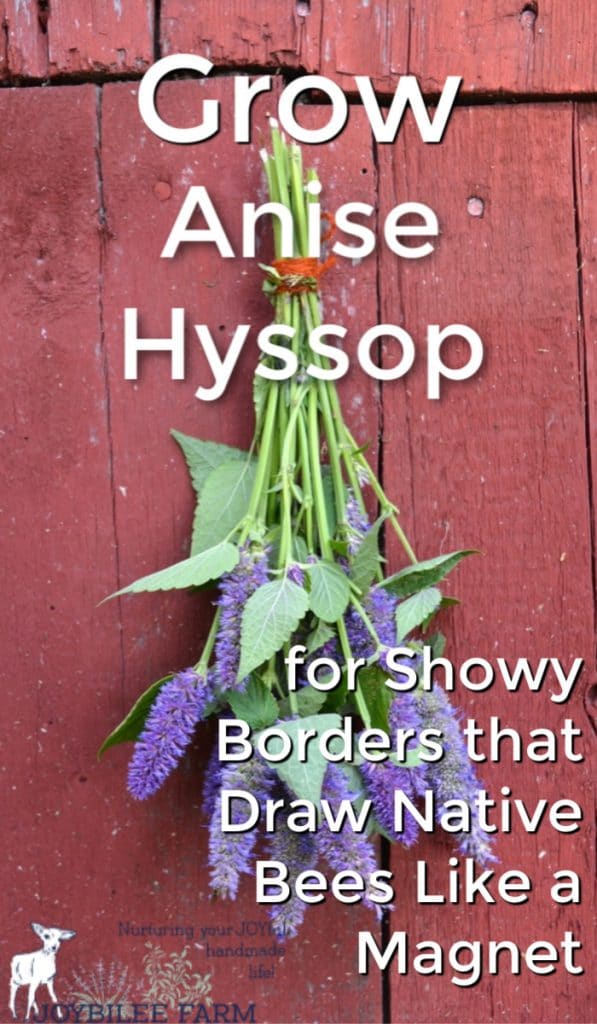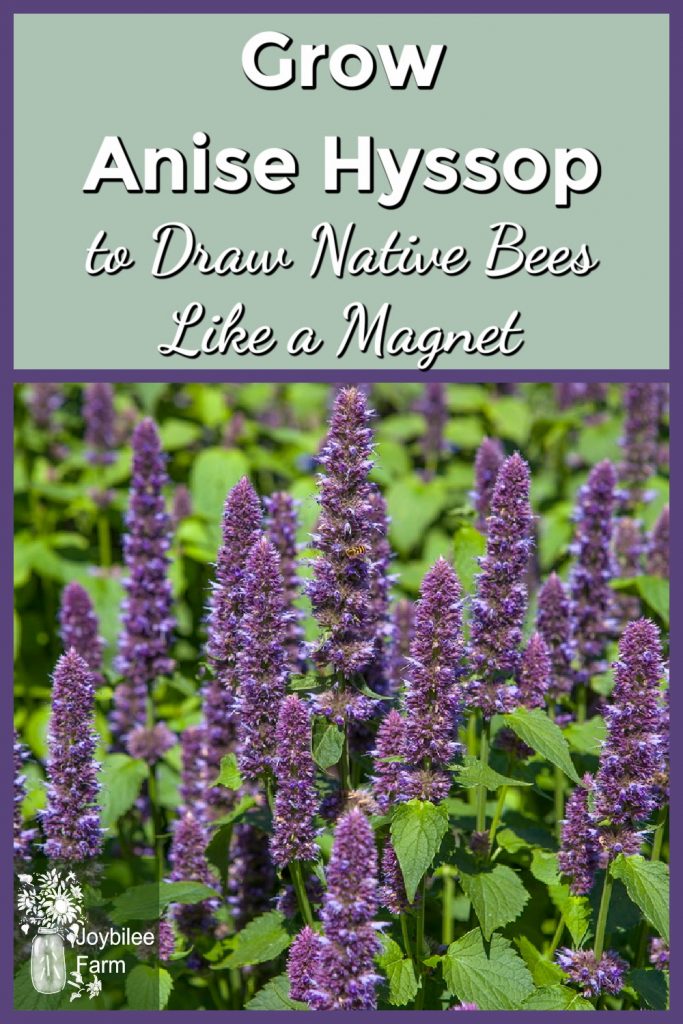Grow Anise Hyssop for Showy Borders that Draw Native Bees Like a Magnet
Learn to grow anise hyssop for an easy pollinator focus. Anise hyssop or Agastache is a showy perennial herb in the mint family, that is easy to grow from seed. It can sometimes bloom in the first year from seed planted in the spring. With showy lavender or blue spikes, fragrance, and nectar Anise Hyssop is a must in both the herb garden and the perennial flower bed.
Attractive to wild bees and butterflies
Blue, lavender, or pink flowered Agastache foeniculum (Anise Hyssop) or A. rugosa (Hummingbird mint), are often used in borders and flower gardens, for their strong vertical accent and long blooming flower spikes. It doesn’t spread as aggressively as other mint family plants and doesn’t require root containment.
Anise Hyssop grows 3 to 4 feet tall in fertile ground and has a one to two-foot spread. It open-pollinated varieties reseed easily so a few plants will keep you going for a long time.
Considered a short-lived perennial, expect to replant it and renew the bed every 3 or 4 years. Some varieties of agastache will self-seed, but hybrids are sometimes sterile. Different varieties of agastache will cross-pollinate, so be sure and remove any plants with unwanted characteristics.
Anise hyssop is attractive to butterflies, wild bees, and hummingbirds because of the rich nectar in the flower spikes. It is lovely planted in a mass planting along with Echinacea, Monarda, and bee balm, all hardy perennials that encourage pollinators. It offers substantial nectar to honeybees when planted in mass plantings, resulting in lightly fragrant honey. One acre of agastache can support 100 honeybee colonies, it is so rich in nectar.
Agastache is especially attractive to butterflies and moths. Grow anise hyssop away from the vegetable garden to lure cabbage moths away from cabbage and broccoli plants. Avoid planting it near radishes.
A prairie native, it is hardy in zones 3 to 8. In colder areas grow anise hyssop as an annual. Anise hyssop is drought tolerant once it is established. It’s a good candidate for xeriscaping. It is also frost hardy and will continue to bloom after the first few touches of frost until you get a killing frost in your area. It dies back to the ground in winter, renewing growth the following spring, as soils warm up.
Plant anise hyssop in full sun for best effect in cooler areas. If you have a hot summer, it will also thrive in part shade. It prefers cooler, temperate summers rather than hot. Anise Hyssop is a very low maintenance plant that looks good in both the front yard and the back.
But that’s not its only benefit in your cool climate garden. All parts of the Agastache foeniculum are edible. The leaves and flowers are used as herbs in soup and salad. The leaves and flowers can be used to flavor syrup or cordial. Dried leaves and flower spikes make a flavorful tea herb. Anise hyssop is also a medicinal herb.

How to grow Anise Hyssop
Plant seeds indoors from February to March if you want flowers in September or October. Anise hyssop is somewhat frost hardy and will continue to bloom until you get a killing frost. Or sow seed outdoors in April to June for flowers the following June. Agastache is one of the first flowers to open in spring and one of the last to die back in the Fall. Once the flowers open you’ll get a continuous show of flowers until the killing frost in the Fall.
You can also sow agastache seed directly in the ground in autumn when the soil is still warm. Cover the seedlings to protect them over the winter. They will bloom the following spring.
Anise hyssop seeds benefit from a short chilling period before planting. Place seeds in damp peat moss and hold them at 4°C for a week before planting them indoors in flats. Outdoor temperatures are cool enough in the spring that this chill period is met with direct planting outdoors 3 weeks before your last frost date.
Anise hyssop needs light to germinate so don’t cover the seeds with soil when you plant. The optimal soil temperatures for germination are 55°F (22°C). Germination takes 14 to 21 days. If planting indoors to get a head start on the season, a little cinnamon on the soil surface of seedling pots will prevent damping off while you wait for the seedlings to emerge. Keep the soil damp by watering from under the pot.
Once plants have 2 sets of true leaves they can be hardened off and then transplanted where you want them to grow. Set out plants 12 inches apart in staggered mass border plantings.

Notable Agastache cultivars to grow
Although native anise hyssop (A. foeniculum) is known to be hardy to zone 2, many of the following award-winning hybrids of Agastache have never been tested in areas colder than zone 5. Plant in zone 4 and colder as an annual or provide protection from cold. For colder winters choose A. foeniculum open pollinated seed rather than a hybrid if you want to create a perennial bed. Hybrids between A. foeniculum and A. rugosa are sterile, so while their flowers are showy and they are very attractive to pollinators they must be reproduced by cuttings, root division, or tissue culture. Because sterile cultivars do not make seeds they have a longer flowering period. The following are named hybrids that have won awards for their long flowering and stunning beauty.
‘Astello Indigo’
A more tender hybrid of A. rugosa and A. foeniculum, Astello Indigo was the 2012 Fleuroselect gold medal winner. Considered hardy to zone 6 (-10°F) it grows to 20 inches tall with bushy, vigorous growth. It has deep lavender-blue flowers and anise scent and flavor.
Agastache ‘Blue Fortune’
(Agastache aurantiaca) Hardy to zone 2, this agastache hybrid has showy, long-lasting, lavender-blue flower spikes that grow to 30 inches tall with a spread of 18 inches. The leaves have a mild anise scent and flavor. It received the Royal Horticultural Society’s Reward of Garden Merit. This cultivar is sterile and will not self-seed.
Agastache ‘Bolero’
A smaller hummingbird mint that grows only 16 inches tall with bold fuchsia-rose colored spikes. The leaves smell of mint when crushed.

Agastache “Golden Jubilee”
With chartreuse foliage and lavender-blue flowers, Golden Jubilee is the All-American Selections Award Winner for 2003. It has mint-scented foliage and is of the Hummingbird mint class of agastache plants. It is another shorter selection with a 20-inch height and spread.
Agastache “Blue Boa”
Winner of the “Too Good to Be True Award” at Colorado State University perennial trials, this anise hyssop has dark green foliage and violet flower spikes, with large flowers that attract hummingbirds. It is a by-chance hybrid.
You can find these showy hybrids at garden centers or at online nurseries. There are no seeds available for these hybrids. They will not produce seeds in your garden.
After the anise hyssop harvest
When you grow anise hyssop in a large swath for pollinators, for show, and for fragrance you’ll get many blooms for the flower cutting garden but you’ll also get a substantial number of bunches for culinary and medicinal use. See this post for ways to use this often overlooked bounty in both the kitchen and the apothecary chest.





Leave a Reply